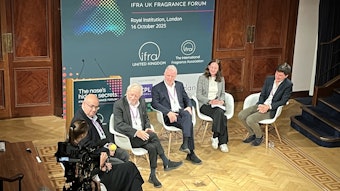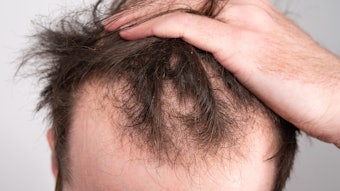Do you find stimulation in a steaming cup of caffeinated coffee? Caffeine is the bitter, crystalline alkaloid C8H10N4O2 named by the 19th century German chemist Friedrich Runge. It is found in coffee, tea and other food substances. Caffeine is a psychoactive stimulant drug and a mild diuretic in humans and other animals.
Caffeine’s principal mode of action is as an antagonist of adenosine receptors in the brain. That’s how it can keep you awake and alert. Caffeine acts through multiple mechanisms involving both action on receptors and channels in the cell membrane, as well as intracellular action on calcium and cAMP pathways.
Its action on channels in the cell membrane is of particular interest to scientists who focus on skin and hair care in the upstream research division of Procter & Gamble Beauty. In a recent patent, these scientists identified caffeine as one of 40 compounds capable of stimulating aquaporins, the proteins that function as water-transporting channels in skin cell membranes (Figure 1).
A previous “Bench & Beyond” column, published in May 2008, discussed the history and water-transport mechanism of aquaporins. The current column will look at the separate but parallel paths followed by a major personal care manufacturer and a principal academic researcher in their attempts to understand what it means to stimulate aquaporin-3 (AQP3), the water channel protein in human skin.
Upstream Research at P&G
P&G Beauty’s upstream research program is dedicated to the understanding of skin and hair biology and physiology. It is cutting-edge, usually unpublished and rarely shared with competitors. An example of cutting edge approaches is the use of genomics and/or proteomics, the study of the expression of various genes or gene products (proteins) by an organ or organism, to provide greater insights into skin and hair physiology. These two areas, genomics and aquaporins, came together in 1999–2000 in some genomics experiments in which skin cells grown in culture were treated with retinoids, well-recognized skin antiaging technologies, and then evaluated for changes in the expression of specific genes. “Expression is a term borrowed from molecular biology, where it describes whether or not a specific protein is present in the tissue being studied,” explained Elizabeth Jewell-Motz, PhD, a senior scientist at P&G Beauty. “In this case we were using gene expression to identify the molecular determinants of the irritation and efficacy of retinoids. We wondered if we could learn something that we could apply to our products that could help us achieve retinoids’ benefits without retinoids’ irritation.
“In the course of these experiments we identified that retinoids produced a nearly 10-fold upregulation in AQP3, as measured at the level of the messenger RNA. Of course, the central dogma of molecular biology is that DNA gets transcribed into mRNA, which gets translated into proteins, which then have to undergo quite a lot of processing to get into the membrane in a form that allows them to be functional,” Jewell-Motz continued.
“Nevertheless, there was a significant upregulation of aquaporin with retinoid treatment, which is one of the reasons we really became interested in this protein. These genomics/proteomics experiments were conducted prior to Dr. Verkman’s 2002 seminal publication demonstrating the role of AQP3 in modulating skin moisture content. That’s why I believe that P&G is really on the cutting edge in this work. The upstream efforts were identifying genes or proteins that might be playing a role in modulating skin hydration, but it was relying a lot on leaders in the academic community like Dr. Verkman to establish the functional role AQP3 plays in skin physiology. That’s exactly where the researchers in academics were in their thinking at that time about how AQP3 may contribute to a functional epidermis in skin.”
P&G Beauty scientists did not follow up on the detailed mechanism of aquaporin’s upregulation. Instead, they concentrated on using AQP3 as a possible biomarker of skin moisturization, the end result of aquapoprin upregulation. “We are most interested in understanding particular skin conditions, such as dry versus hydrated skin or young versus old skin. The information gained from both our experiments and those found in the literature allowed us to propose that aquaporin may be a biomarker of younger, more moisturized skin,” Jewell-Motz said.
Verkman and the Glycerol Connection
The Dr. Verkman to which Jewell-Motz refers is Alan S. Verkman, MD, PhD, professor of medicine and physiology at University of California, San Francisco’s Department of Medicine. His research is typically with mice and culture systems. Of his several hundred publications, the earliest one listed on his Web site4 and dealing with aquaporins is from 1997, and reports his work on the generation and phenotype of a transgenic knockout mouse lacking AQP4.
In 2002 Verkman published a paper5 drawing attention to the glycerol transporting function of AQP3. It had been known since 1994 that AQP3 is an aquaglyceroporin, i.e., permeable to both water and glycerol.6 Verkman’s paper reported that selectively reduced glycerol in skin of AQP3-deficient mice may account for impaired skin hydration, elasticity and barrier recovery.5 A year later he disclosed that glycerol replacement, either topically or systemically, could correct those impairments.7
In 2008 he reported that AQP3 facilitates epidermal cell migration and proliferation during wound healing8 and that targeted AQP3 gene disruption is associated with reduced skin tumorigenesis and impairment of epidermal cell proliferation.9 Results from the later paper and the published work of other researchers suggested to Verkman10 the possibility of developing pharmacological agents to alter AQP3 expression or function for treatment of skin diseases associated with abnormal proliferation or water homeostasis.
Also in 2008 came Verkman’s cautionary note on cosmetics containing ingredients that increase AQP3 expression.3,11 He argued that caution seems warranted in targeting AQP3 to increase skin moisturization based on his discovery of an association in mice between epidermal AQP3 expression and skin tumor formation.
In a 2008 review of the roles of AQP3 in the epidermis,10 Verkman proposes a mechanism for AQP3-dependent skin hydration, wound healing and tumorigenesis (Figure 2) and writes the following:
Phenotype analysis of AQP3-null mice supports several distinct roles of AQP3 in keratinocyte biology. AQP3-facilitated water transport is involved in cell migration, accelerating healing of cutaneous wounds. AQP3-facilitated glycerol transport is involved not only in skin hydration and elasticity, based on the humectant properties of glycerol, but also in cell proliferation. We propose AQP3-facilitated glycerol transport to be of central importance in generating ATP, which facilitates the cell growth and tumorigenesis. AQP3 may serve other functions in keratinocytes as well, based perhaps on AQP3 protein-protein interactions.
Jewell-Motz remembers those 2002 and 2003 papers very well. “Right after we started our in vitro work on aquaporins and identified in our culture systems that AQP3 was upregulated by retinoids, Dr. Verkman published his 2002 paper. In this work, he deleted the gene for AQP3 in mice so they no longer expressed AQP3 in the skin. He found that those mice actually had dry skin. That was amazing. Whenever you’re able to knock out a gene and then see an effect, it’s pretty good proof that that gene is important in that particular process.
“His 2003 paper showed that glycerol replacement actually corrected many of the skin issues that he saw in the AQP3 knockout mouse. He was able to correct them by adding glycerol either topically or systemically, i.e., by putting glycerol in the mouse’s drinking water. That is a really neat finding,” Jewell-Motz said.
There were several important findings in Verkman’s 2003 paper:
• Stratum corneum water content measured by skin conductance (instrumental measurementsa and use of isotopes to look at water accumulation) was three-fold lower in the mice that did not have AQP3 versus the mice that did. “That was after topical or systemic administration, so it tells us that the amount of glycerol obtained within the stratum corneum is important for maintaining the amount of water or hydration within the skin,” Jewell-Motz said.
• The mouse without AQP had reduced elasticity (measured by displacement of the skin after suction). Restoration of glycerol corrected the elasticity.
• Barrier recovery (measured by TEWL measurements after tape stripping) was delayed in mice with AQP3. Some experiments used radioisotope-labelled glycerol and looked at how quickly the amount of glycerol in the blood was then transported to the stratum corneum to be incorporated into lipids, for example. In the AQP3-null mouse, that transport was actually much slower than in the mouse that had AQP3s.
“I think overall Dr. Verkman has done amazing work in fleshing out some of these mechanisms. His most recent publications make a strong case for the position that the primary role of AQP3 is its glycerol-handling function,” Jewell-Motz said.
“Obviously P&G is interested in moisturization, so Verkman’s work with knockout mice is really important to us. We rely heavily on the work that is done by academicians and published in the literature, as does the entire scientific community. This literature provides us with a great deal of detailed mechanistic understanding of skin.”
Regarding Verkman’s most recent assessment of aquaporins and their link to skin tumorigenesis,8,11 Jewell-Motz said: “There is obviously more work that will be required to firmly establish the relevance, if any, of this connection and we will be looking to the academic community as an important contributor to this additional understanding.”
P&G and AQP3 Stimulation
By 2006, P&G Beauty had developed a pair of poster presentations12,13 detailing the group’s efforts to determine AQP expression levels in dry versus nondry skin and in aging skin. The posters also detailed the group’s efforts to develop
in vitro methods using AQP3 in human skin cells as a marker to identify compounds that might be good skin moisturizers.
The researchers used a DNA micro arrayb to quantitate AQP mRNA expression in punch biopsies from 20 Caucasian female subjects as an in vivo measure of AQP3 expression. They used ELISA (Enzyme-Linked ImmunoSorbent Assay) to analyze AQP3 protein in cultured human keratinocytes (skin cells)c as an in vitro measure of AQP3 expression.
The researchers also developed a glycerol transport assay that probed at whether the increase in AQP3 levels resulted in increased AQP3 function. For this assay, cultures of human skin tissue modelc were treated with the test compound for 48 hr. Then glycerol was added to the culture medium in the chamber underlying the skin tissue model. Glycerol levels within the chamber medium containing the skin tissue model were determined 24 hr later.
The upstream program at P&G then evaluated known cosmetic ingredients in these in vitro assays to determine if they might elevate AQP3 levels and glycerol transport. Some of these ingredients were then formulated as a moisturizer and evaluated in a human dry leg study to see if they would deliver a skin benefit, such as moisturization. To make this determination, expert visual grading was used to evaluate the moisturization benefit of a caffeine-containing formulation. Caffeine is “generally recognized as safe” (GRAS) for use in foods by the US Food and Drug Administration and functions as a skin conditioning agent in cosmetic and personal care products.14
The findings from this collection of experiments were the following:
• AQP3 mRNA expression was quantitated in skin and varied with body site, skin condition and/or age. An age-associated decrease in AQP3 correlated with an age-associated increase in dry skin.
• Caffeine stimulated AQP3 expression by cultured keratinocytes. Enhanced expression was dose-dependent.
• Caffeine also stimulated AQP3 expression in stratified keratinocytes from the model human skin tissue systemc.
• Caffeine increased both the protein expression and the glycerol transport activity of AQP3 as determined
in vitro.
• The moisturizer formulation containing caffeine delivered a moisturization benefit to dry skin in clinical testing.
“Caffeine increased both the protein expression and glycerol transport activity of AQP3 as determined in vitro,” Jewell-Motz said. “That’s important because those are two critical endpoints. They tell you how much of the protein is present and how well it is performing the function it’s supposed to perform.
“In addition, it was observed that AQP3 and AQP9, another aquaporin family member, were also present in keratinocytes in culture,” Jewell-Motz continued. “The importance of this finding is that often times what we observe in human tissue differs from what we see in culture. Therefore, the expression of the aquaporins in skin cells in culture may indicate that these cells represent an appropriate system in which to study aquaporins and their role in the skin.”
At this time, research into aquaporins was increasing exponentially, both within academia and across the private sector. This was leading to the publication of several papers on aquaporins in skin and other organ systems, and the submission of several patents to establish some freedom-to-practice in this highly competitive field. To this end, a 2007 US patent application2 from P&G discloses personal care compositions comprised of at least one ingredient from each of two ingredient groups in a dermatologically acceptable carrier. One group consists of niacinamide, glycerin and mixtures thereof. The other group consists of aquaporin-stimulating compounds—of which 40 are named—and their mixtures. Some of the aquaporin-stimulating compounds are well-established cosmetic ingredients, such as caffeine, green tea, menthol, tea tree oil and kinetin. Others disclosed were Ajuga turkestanica extracts and various ginsenoside compounds that are components of ginseng extract. Formulations for exemplary emulsions, gels and mousses are presented in the patent application. Formula 1 shows an example of a skin gel formulation containing caffeine.
By precisely what mechanism do these compounds stimulate aquaporins? That’s not clear. We know from the posters previously mentioned that caffeine stimulated AQP3 expression and increased glycerol transport activity in a human skin culture system and that similar tests were used to identify all compounds included in the patent. According to Dr. Elizabeth Jewell-Motz, the importance of the posters and the patent is that AQP3 can be considered to be an important biomarker of moisturized skin. “By using the relative expression or activity of this biomarker as an indicator of moisturized skin, cosmetic materials that have the potential for delivering moisturization benefits may be identified,” she said.
Comment
This column makes several points.
• As with most cosmetic manufacturers, upstream research at P&G focuses on the cosmetic benefits of ingredients in product formulations, rather than on the mechanisms of those effects. Questions about the precise mode of action are usually of more academic interest.
• This column has discussed two aspects of aquaporin stimulation: expression and function. That means how much of the protein is present in the tissue, and how effectively the protein does its job of transporting water and glycerol. Other aspects of aquaporin stimulation may be the subject of future “Bench & Beyond” columns.
• Dr. Alan Verkman’s knockout mice studies in 2002–2003 and his subsequent AQP3 publications have shifted cosmetic interest in this aquaglyceroporin from its water transport function to its glycerol transport function and increased the industry’s understanding of the proper functioning of the skin.
Now let’s return to that steaming cup of coffee. The cup is a channel through which water and other molecules pass to moisturize a living organism, in this case the human body. The sugar is a glycerol. Caffeine is a stimulant. The analogy between a cup of coffee and aquaporin-3 has its weaknesses, but perhaps this column will stimulate you to think about them.
Reproduction of all or part of this article is strictly prohibited.
References
1. Wikipedia Web site, available at: http://en.wikipedia.org/wiki/Caffeine (Accessed Apr 23, 2008)
2. US Pat Applic 20070009474, Personal care compositions and methods for the beautification of mammalian skin and hair, S Zie et al, assigned to The Procter & Gamble Company (Jan 11, 2007)
3. B Brewster, Aquaporins: The one-molecule-at-a-time moisturizer, Cosmet Toil 123(5) 24–32 (2008)
4. A Verkman, University of California, San Francisco, available at: www.ucsf.edu/verklab/People/CVs/Verkman-CV.pdf (Accessed Apr 23, 2008)
5. M Hara, T Ma and AS Verkman, Selectively reduced glycerol in skin of aquaporin-3-deficient mice may account for impaired skin hydration, elasticity, and barrier recovery, J Biol Chem 277 46616–46621 (2002)
6. K Ishibashi et al, Molecular cloning and expression of a member of the aquaporin family with permeability to glycerol and urea in addition to water expressed at the basolateral membrane of kidney collecting duct cells, Proc Natl Acad Sci USA 91(14) 6269–6273 (1994)
7. M Hara and AS Verkman, Glycerol replacement corrects defecting skin hydration elasticity, and barrier function in aquaporin-3-deficient mice, Proc Natl Acad Sci USA 100 7360–7365 (2003)
8. M Hara-Chikuma and AS Verkman, Aquaporin-3 facilitates epidermal cell migration and proliferation during wound healing, J Mol Med 86 221–231 (2008)
9. M Hara-Chikuma and AS Verkman, Prevention of skin tumorigenesis and impairment of epidermal cell proliferation by targeted aquaporin-3 gene disruption, Mol Cell Biol 28 326–332 (2008)
10. M Hara-Chikuma and AS Verkman, Roles of aquaporin-3 in the epidermis, J Invest Dermatol (in press)
11. AS Verkman, A cautionary note on cosmetics containing ingredients that increase aquaporin-3 expression, Exper Derm (accepted for publication in 2008)
12. JR Kaczvinsky et al, Determination of aquaporin expression in keratinocytes and human tissue, available at: www.pgbeautyscience.com/aquaporin-expression-in-keratinocytes-and-human-tissue.html (Accessed Apr 23, 2008)
13. EA Jewell-Motz et al, Modulation of aquaporins to deliver consumer benefits: Applications for skin care, available at: www.pgbeautyscience.com/assets/files/posters/AAAS2007/Aquaporin%20Jewellmotz.ppt (Accessed Apr 23, 2008)
14. US FDA Web site, available at: www.accessdata.fda.gov/scripts/cdrh/cfdocs/cfcfr/CFRSearch.cfm?fr=182.1180&SearchTerm=caffeine (Accessed Apr 30, 2008)










